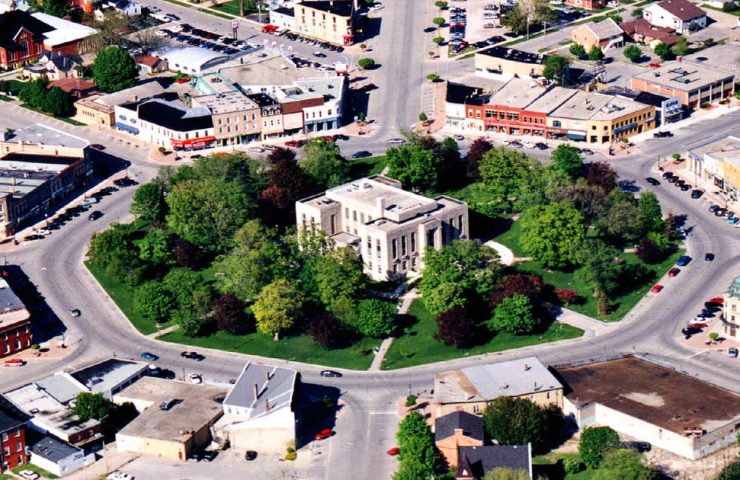Secondary Lessons
)
Title
Municipalities
Guiding Questions
How do municipalities influence communities? What would I like to change about my community?
SUMMARY
Municipalities are responsible for providing their communities with essential local services and for managing the growth and well-being of the community.
In this lesson, students start by taking turns learning from one another about their municipality, sharing their information using a Give One-Get One approach. After learning about municipalities in Ontario more generally, students complete a scavenger hunt about their school’s municipality. Students will identify an issue they believe is most pressing in the community and complete a case study, where they research the facts and examine opposing viewpoints. In the consolidation activity, they will identify and assess potential actions that could be taken by the municipal government and/or citizens to address the issue.
LEARNING GOALS
By the end of this lesson, students will be able to:
- Develop an understanding of the structure and function of municipalities (Citizenship Education Framework – Structures);
- Use the inquiry process to formulate questions, interpret, synthesize and critically analyze information about their municipality;
- Compare and contrast different viewpoints about the same political issue (Concepts of Thinking – Political Perspective);
- Identify and assess actions to improve their municipality (Concepts of Thinking – Political Significance).
SUCCESS CRITERIA
- I can explain the purpose and features of municipalities;
- I can ask questions, gather and interpret information about our municipality;
- I can research and analyze an issue that matters to me and compare different viewpoints on the issue;
- I can identify and assess different ideas or actions to address the issue and improve our community.
CURRICULUM LINKS
CHV2O – A1, A2, B2, A1.1, A1.2, A1.3, A1.5, A1.7, A2.2, B2.4
MINDS ON
Assess current knowledge among students about your school’s municipality using a Give One-Get One approach.
- Ask students to brainstorm a list of all the things they already know about their municipality in the left-hand column (Activity 4.1). Encourage four to five bullets.
- After making the list, have students stand and find a partner. Each person should “give one” of their ideas by saying it out loud. Partners take turns sharing.
- Have students write any new information they get from these discussions in the “get one” column of their lists.
- Students should rotate around the room, talking to two or three partners.
- Once everyone has given and received information, the whole class can discuss the information students have listed.
ACTION
1. Using the accompanying slide deck and/or the ‘Municipalities in Ontario’ video (2:46 min) to review the following.
- What is a municipality? How many exist in Ontario?
- What features does a municipality have?
- What are different types of municipalities in Ontario?
2. Ask students to complete an online scavenger hunt about their local municipality (Activity 4.2). Give students time to complete it independently or in pairs and then share their responses in small groups.
3. Using a Think-Pair-Share approach, ask students to consider their responses to the following questions:
- What do you like most about your municipality?
- What would you change or improve about your municipality?
4. Provide copies of Activity 4.3 and ask students to complete a case study about the most pressing issue facing their community. Students should use primary and secondary resources, such as the municipality’s website, newspapers and media websites.
Guiding questions:
- Identify an issue: What do you think is the most pressing issue in your municipality? How can you frame it as a question?
- Find the facts: Which facts are relevant? Who is impacted? What statistics are available? What steps has the municipal government taken to address the issue?
- Research different views about the issue: What are two opposing viewpoints about the issue? What different solutions have been proposed?
- Analyze the information and reach a conclusion: Based on the research, what is your position on the issue? Why?
Teacher note: Students need to think critically about what they see online, develop the habits to verify information and establish a trusted list of sources. Show your students the NewsWise ‘Online Verification Skills’ video series to review key tips and tricks for source verification.
Alternative Activity:
1. By-laws are the primary legislative instrument of municipalities in Ontario. The elected council makes decisions by adopting or amending recommendations from its committees and municipal officials contained in reports and communications. Ask students to research a recent by-law passed by their council and complete Activity 4.4. In advance of the assignment, review the concept of objectives and results.
Teacher note: Objectives and Results is a political thinking concept that focuses on factors leading to events, decisions, and/or plans of action and their intended and unintended consequences.
2. In small groups or through a whole class discussion, have students share their by-law research and analysis.
CONSOLIDATION
Through a written reflection, ask students to consider their responses to one or more of the following questions:
- What actions could the municipal government or citizens take to address the issue you identified in the case study? Who would be impacted by these actions and how?
- Why is it important to be an active and engaged member of the community?